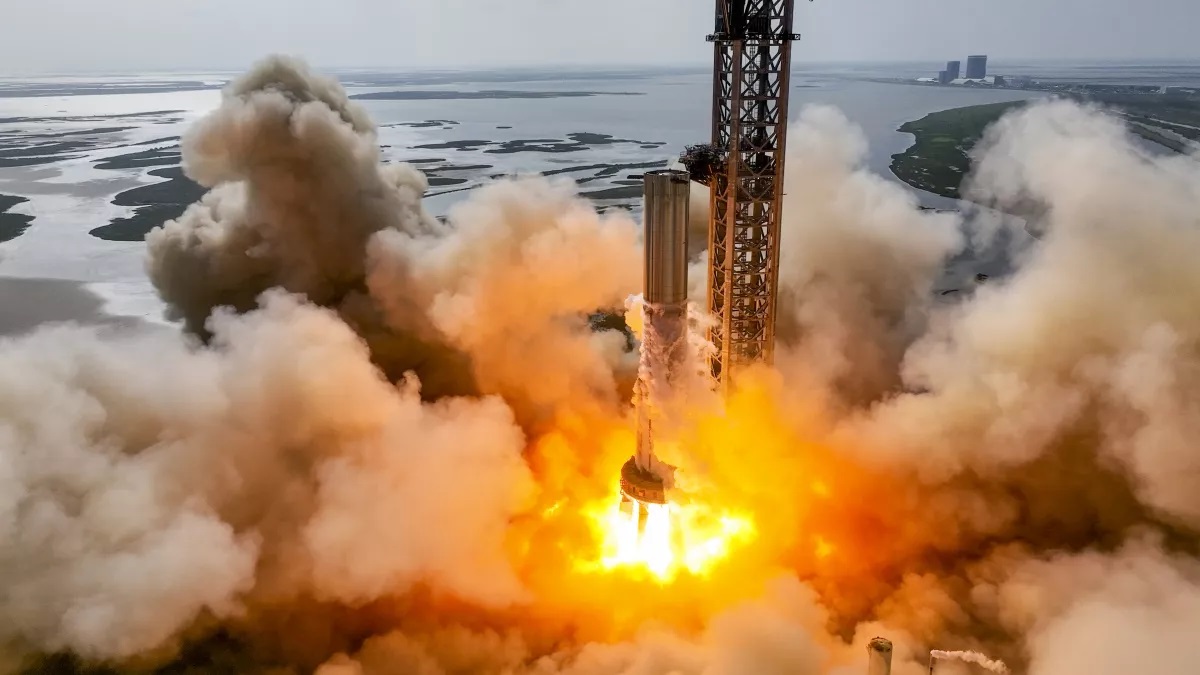SpaceX is at it again! Yesterday (November 29th), the company conducted another static fire test with the Booster 7 (BN7) prototype at its Starbase in Boca Chica, Texas. The test began at 02:42 p.m. EST (11:42 a.m. PST) and saw eleven of the BN7’s thirty-three Raptor 2 engines fire for 13 seconds. While static fire tests have been the norm these past few months, this latest might be the prelude to the orbital test flight Musk has been hinting at for close to a year. News of the successful test was shared via Twitter, while NASA Spaceflight (NSF) shared footage of the test via Youtube.
The last time SpaceX conducted a static fire test with the BN7 was on November 17th, when fourteen of its Raptor 2 engines were fired for thirteen seconds. Before that, SpaceX conducted a test on September 19th, where the BN7 fired seven Raptor 2 engines for about seven seconds. These tests came after many months of stacking and unstacking and repeatedly revised estimates of when the orbital test flight may occur. Musk previously indicated it might fly in May, July, and sometime in November.
But after the September 19th test, Musk offered a more detailed assessment of when the Starship could be ready to go to space. After sharing NASA Spaceflight’s footage of the test via Twitter, NSF Managing Editor Chris Bergin and Musk got into a brief conversation. When Bergin asked Musk when the orbital flight might happen, he replied, “Next test is ~20 sec firing with max oxygen fill to test autogenous pressurization, possibly one more static fire, then orbital launch attempt.” In short, Musk claims that another static fire is likely to follow this one, followed by an orbital flight.
While Musk did not indicate when that might happen, it’s a safe bet that it won’t take place before 2023. If successful, the flight test will make the Starship and Super Heavy the most powerful launch system in history. The title used to be held by the Saturn V rocket that took the Apollo astronauts to the Moon and is currently held by NASA’s Space Launch System (SLS). The SLS earned this title after launching from the Kennedy Space Center in Florida at 01:47 a.m. EST on November 16th (10:47 p.m. PST, November 15th)
The Artemis I mission has subsequently established a new record for the farthest distance ever achieved by a spacecraft. The uncrewed Orion vehicle also took some amazing photographs of the Moon and the Earth-Moon system in the process. NASA has already contracted with SpaceX to provide the Human Landing System (HLS) for the Artemis III mission, which is currently scheduled for 2025. This historic mission will see astronauts land on the lunar surface for the first time since the Apollo Era.
According to NASA’s mission architecture, the Artemis III crew will launch aboard an Orion spacecraft atop an SLS rocket and fly to the Moon, where they will rendezvous with the Starship HLS in lunar orbit. The crew will then transfer to the HLS, land on the Moon, and conduct surface operations before launching again to return to their Orion spacecraft (and then return home). The SLS will have to give up the title of “most powerful rocket” after a few short months but will remain a vital part of the Artemis Program.
And be sure to check the SNF’s footage of the latest static fire test of the BN7 below:


Booster B7 has been lowered onto a transport stand and rolled away from the launch site, likely in preparation for a road closure and transport to a high bay next week.
That looks promising, they need to mount the engine skirts so the current tests may have given them confidence that it is time for the 33 engine test before stacking booster B7 and Starship S24 for the wet dress rehearsals. And that likely means the close to 20 s full LOX tank engine test was a sufficient test of autopressurization for a booster (return and) test landing at the Starship Orbital Flight Test.
NASAs cheat sheet has the final point of FAAs license processing as “in work”. And they also have an additional hull strengthening and tile replacement ongoing for Starship S24 that has surfaced since the sheet was produced. The OLM with ongoing cladding et cetera is a work in progress, but they seem to have enough functionality for a launch. The flight test can happen any week soon.
Re “the flight test will make the Starship and Super Heavy the most powerful launch system in history. The title used to be held by the Saturn V rocket that took the Apollo astronauts to the Moon and is currently held by NASA’s Space Launch System (SLS).”
Nitpicking, that should be either massive or orbital launch capability or powerful launch system that reached orbit, since the massively engineered Soviet N1 booster will be the most powerful booster launched until Starship launches. Its 30 engines delivered 45 MN of thrust at sea level versus Saturn V 33 MN, while Starship 33 engines promise to deliver 76 MN.